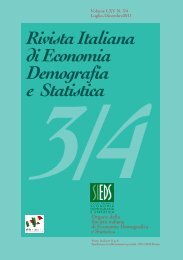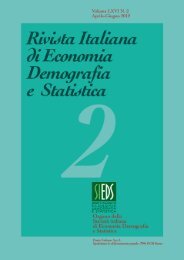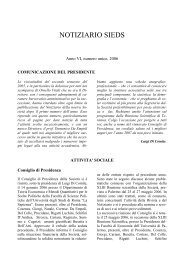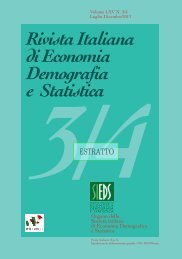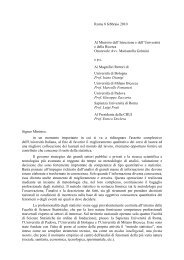rivista italiana di economia demografia e statistica - Sieds
rivista italiana di economia demografia e statistica - Sieds
rivista italiana di economia demografia e statistica - Sieds
You also want an ePaper? Increase the reach of your titles
YUMPU automatically turns print PDFs into web optimized ePapers that Google loves.
212<br />
Volume LXIII nn. 3-4 – Luglio-Dicembre 2009<br />
might be reluctant to sell their own home and make profit by their redundant<br />
housing capacity (e.g. when children leave the nest). Many authors underline the<br />
paradox of the “cash poor/house rich” elderly (Lefebure et al. 2006, Castles 1998).<br />
SHARE data confirm previous research fin<strong>di</strong>ngs that ownership rates decline<br />
considerably with age in most countries. However, a large part of the decline is<br />
found to be attributed to cohort effects (Chiuri, Jappelli, 2006; Börsch-Supan et al.<br />
2005). Interestingly, ownership patterns across age are quite similar across<br />
countries, with the partial exception of Me<strong>di</strong>terranean Countries where ownership<br />
acquisition is stable since long term (Kohly et al. 2005, Castles, Ferrera 1996).<br />
From a comparative perspective, variations in national housing tenure patterns<br />
can be explained by many factors: historical influences, cultural variations (e.g. in<br />
inter-generational transfers of wealth), economic cycle, housing and financial<br />
markets, and institutional arrangements (Lefebure et al. 2006). Variety in home<br />
tenure structure impinge on poverty <strong>di</strong>fferences between countries and groups<br />
(Börsch-Supan et al. 2005, Lefebure et al. 2006). An owner occupier is in<br />
significantly better position than a renter with the same income and stu<strong>di</strong>es on<br />
economic well-being should take into account this issue (Börsch-Supan et al.<br />
2005). Conversely, those who are poor are definitively worse off if they have also<br />
to pay a rent.<br />
This paper is aimed at verifying if older poor Europeans are “house rich”, or<br />
rather if monetary poverty prevents them to live in their own home, so that social<br />
policies should take them into account. Using a logistic regression model, we<br />
delineate the profile of old people who do not have access to home ownership,<br />
keeping into account a plurality of covariates related to personal background, to<br />
familial characteristics, and opportune combination of them. In particular we are<br />
interested to identify the fragile profiles – with regard to poverty status, living<br />
arrangement and gender – having a higher risk of being excluded by home<br />
ownership.<br />
2. Data and descriptive fin<strong>di</strong>ngs<br />
We take our data from the database “Survey of Health, Aging and Retirement in<br />
Europe” (SHARE 2.0.1: Börsch-Supan et al., 2005). SHARE is a multi<strong>di</strong>sciplinary<br />
and cross-national database of freely accessible micro data on health, socioeconomic<br />
status and social and family networks of in<strong>di</strong>viduals aged 50 or over. The<br />
analysis is carried out on a sub-sample of about 28.000 in<strong>di</strong>viduals, aged 50 or<br />
over, living in Austria, Belgium, Denmark, France, Germany, Greece, Italy, the<br />
Netherlands, Spain, and Sweden. SHARE data show that the rate of home ownership<br />
among the older European varies substantially across countries: rates range from<br />
more than 50% of Germany, Austria and Sweden to more than 80% in Spain and



